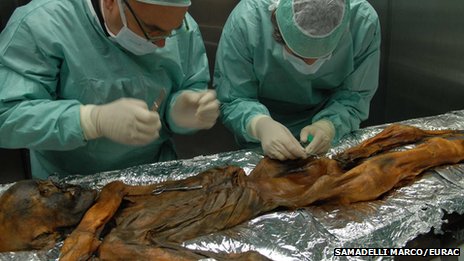Oetzi's full genome has now been reported in Nature Communications.
It reveals that he had brown eyes, "O" blood type, was lactose intolerant, and was predisposed to heart disease.
They also show him to be the first documented case of infection by a Lyme disease bacterium.
Analysis of series of anomalies in the Iceman's DNA also revealed him to be more closely related to modern inhabitants of Corsica and Sardinia than to populations in the Alps, where he was unearthed.
'Really exciting'
The study reveals the fuller genetic picture as laid out in the nuclei of Oetzi's cells.

Oetzi's mitochondrial DNA had already revealed some hints of his origins when it was fully sequenced in 2008.
Albert Zink, from the Eurac Institute for Mummies and the Iceman in Bolzano, Italy, said the nuclear DNA study was a great leap forward in one of the most widely studied specimens in science.
"We've been studying the Iceman for 20 years. We know so many things about him - where he lived, how he died - but very little was known about his genetics, the genetic information he was carrying around," he told BBC News.
He was carrying around a "haplotype" that showed his ancestors most likely migrated from the Middle East as the practice of formal agriculture became more widespread.
It is probably this period of transition to an agrarian society that explains Oetzi's lactose intolerance.
Prof Zink said that next-generation "whole-genome" sequencing techniques made the analysis possible.
"Whole-genome sequencing allows you to sequence the whole DNA out of one sample; that wasn't possible before in the same way.
"This was really exciting and I think it's just the start for a longer study on this level. We still would like to learn more from this data - we've only just started to analyse it."




Wasn't Lyme disease created by the cabal in some lab off the East Coast? Ok, it's been awhile since I read about it, but I thought there was some release of ticks with this disease. How would a neandertal have this disease bacterium present unless the Lyme disease came from him originally?
Curiously begging the question...
Oh yeah, it was Plum Island!
[Link]
So I ask the following questions:
1. Was the Ice man truly discovered 20 years ago, or before?
2. Is there a link to this bacterium being found and perhaps mutated?
Food for thought...